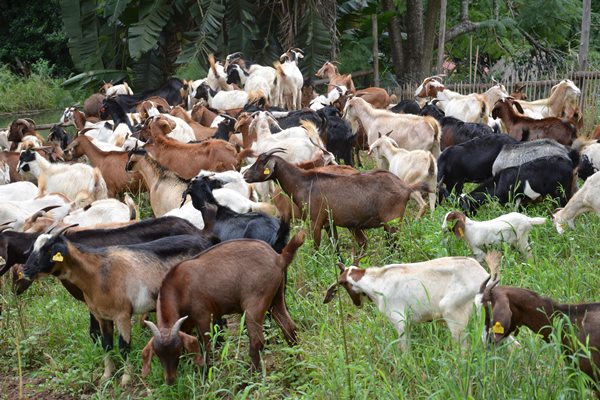

Feeding may be one of the largest expense of any goat operation. Goats raised for meat need high quality feed in most situations and require an optimum balance of many different nutrients to achieve maximum profit potential. Because of their unique physiology, meat goats do not fatten like cattle or sheep, and rates of weight gain are smaller. Therefore, profitable meat goat production can only be achieved by optimizing the use of high quality forage and browse and the strategic use of expensive concentrate feeds. This can be achieved by developing a year-round forage program allowing for as much grazing as possible throughout the year.
Many people still believe that goats eat and do well on low quality feed. Attempting to manage and feed goats in this way will not lead to successful meat goat production. Because of nimble lips, goats are selective feeders, capable of picking off the most nutritious plant parts. On pasture or rangeland, maximum goat gains or reproduction can be attained by combining access to large quantities of high quality forage that allow for selective feeding.
The basic principle of control grazing is to allow goats to graze for a limited time, leaving a leafy stubble, and then to move them to another pasture, a paddock or sub-paddock. Smaller paddocks are more uniformly grazed and surplus paddocks can be harvested for hay. The pasture forage plants, with some leaves still attached, can then use the energy from the sun through photosynthesis to grow back without using up all of their root reserves. Even brush will need a recovery time if it is being used as forage for goats. Without this rest period, the goats can kill the brush through continuous browsing.
Under control grazing, legumes and native grasses may reappear in the pasture, and producers often report that the pasture plant community becomes more diverse. Control grazing can be used to improve the pasture, extend the grazing season, and enable the producer to provide a higher quality forage at a lower cost with fewer purchased inputs. Control grazing can also be useful in reducing internal parasite problems, if meat goat producers are careful to move the goats to a new pasture before the forage plants are grazed too short, that is, less than about 4 inches.
 Contact Jaguza Support
Contact Jaguza Support